COVID-19 boosted excess sale of antibiotics in India

The first wave of COVID-19 in 2020 in India saw a substantial increase in the sale of antibiotic formulations used in adults and adolescents, especially azithromycin, says a study.
COVID-19 likely contributed to about 216 million excess doses of non-pediatric formulations of antibiotics in total and 38 million excess doses of azithromycin between June and September 2020, says the study which looked at the private health care sector in India, and published this month in PLOS Medicine.
Antibiotics are often used in viral infections (e.g. viral pneumonia) to combat possible bacterial co-infections. This is despite antibiotics being ineffective against viral infections, according to the US Centers for Disease Control and Prevention.
Overall, 16.29 million doses of antibiotics were sold in India, the world’s largest antibiotic user. The proportion of non-pediatric formulations of antibiotics increased from 72.5 percent in 2019 to 76.8 percent in December 2020, with children less likely to suffer from symptomatic and severe COVID-19 infection, researchers noted.
Sumanth Gandra, study author and associate professor of the Division of Infectious Diseases, Washington University School of Medicine, US, tells SciDev.Net that the results suggest that nearly every person diagnosed with COVID-19 received an antibiotic—most especially azithromycin—during the first wave in India.
“Our results indicate that at least 12 million azithromycin treatment courses were unnecessarily prescribed between June and December of 2020,” says Gandra. “This massive use of azithromycin, a vital drug for treating typhoid fever and diarrhea, is highly concerning as it will lead to resistance in bacteria that cause these illnesses.”
According to Brian Godman, a visiting professor at the Strathclyde Institute of Pharmacy and Biomedical Sciences, UK, it is important to curb inappropriate use of antibiotics for viral infections which will increase resistance rates and result in greater loss of life in the future.
“This is particularly important in the community since inappropriate prescribing and dispensing of antimicrobials for essentially viral infections constitutes their greatest overuse,” Godman tells SciDev.Net. “Trained pharmacists are important as they can direct patients to more appropriate treatments that are more effective in symptomatic relief and often cheaper. This should be a priority in India given the rising antimicrobial resistance rates.”
Similar trends are likely to have occurred in other low- and middle-income countries where antibiotics are often overused, the study said. The medium- and long-term consequences for bacterial resistance patterns are “highly concerning,” it added, highlighting the need for urgent antibiotic stewardship measures such as avoiding the use of antibiotics if there is no suspicion of bacterial infection, and limiting the duration of antibiotic treatment for co-infections.
India’s approach to antibiotic use during the pandemic was more of a knee-jerk reaction than a well thought-out plan, says Diptendra Sarkar, a COVID-19 strategist, public health analyst and professor at the Institute of Post Graduate Medical Education and Research, Kolkata, India.
“While evolving evidence did not favor the use of antibiotics, there was little governance on the community use of antibiotics,” Sarkar tells SciDev.Net. “Self-medication also played a major role in upscaling antibiotic use that are not evidence-based.”
Source: Read Full Article



